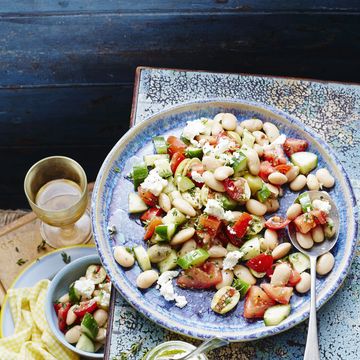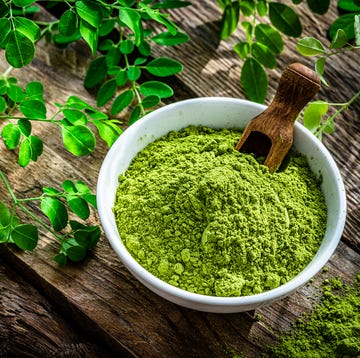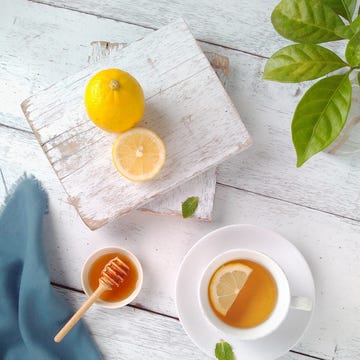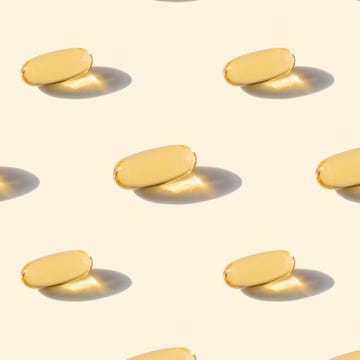Liquids
 YSedova//Getty Images
YSedova//Getty ImagesWhen you have a cold, it can feel like you’re simultaneously dripping like a faucet and all clogged up. You want to stay hydrated to keep mucus membranes moist and thin out mucus for easier drainage. Drinking fluids will also counteract the drying effects of indoor heating and cold weather. There’s no need to go overboard — just drink at least the daily recommended amount, which is around 9 cups for the average woman.
Chicken Soup
 PhotoGeo7//Getty Images
PhotoGeo7//Getty ImagesA steaming bowl of chicken soup is a one-stop curative for common cold symptoms. "It’s truly medicine in a bowl," says Dr. Cooke. The steam releases bad discharge from the nose and may alleviate respiratory symptoms, including congestion and coughing. Dr. Cooke suggests boosting chicken soup's healing potential by adding generous amounts of fresh grated ginger, crushed garlic cloves, and black pepper.
Advertisement - Continue Reading Below
Honey
 Materio//Getty Images
Materio//Getty ImagesHoney is a double threat when it comes to treating common cold symptoms. "Honey coats the throat and soothes coughs," says Dr. Tello. "Studies in pediatric populations show that honey works as well as cough syrup for kids." That said, do not give honey to anyone less than a year old.
Peppermint
 Maya23K//Getty Images
Maya23K//Getty ImagesInvigorating peppermint is a multitasker when battling a cold. Whether as a tea or an essential oil, it can help soothe headaches, clear out sinuses, and relax airways for better breathing. Add to a diffuser, mix with a carrier oil (coconut, almond, or olive oil are all good options) to add to your bath, or try this quick trick: "Put a few drops in your hands and cup around mouth and nose," says Dr. Cooke. “Do slow inhalations for about two minutes." Never apply the essential oil directly to skin as it’s highly concentrated.
Advertisement - Continue Reading Below
Elderberry
 jaye19//Getty Images
jaye19//Getty ImagesThe syrup made from the deep-purple berry has long been used as a folk cure, believed to both shorten the duration and severity of a cold. It is a powerful antioxidant — high in immune-strengthening polyphenols — that can help block viruses in the body, according to a small 2016 study published in Nutrients.
Echinacea
 ALLEKO//Getty Images
ALLEKO//Getty ImagesEchinacea is one of the most well-known natural cold treatments, though it is considered most effective at keeping a cold at bay. Different parts of this flowering plant are used to make teas, oils, and other products. Some studies have shown that taking echinacea as a supplement can cut your chances of catching a cold by up to 58%, and reduce the length of your cold by more than a day.
Advertisement - Continue Reading Below
Saline Rinse
 Kristin Lee//Getty Images
Kristin Lee//Getty ImagesCleansing nostrils with saline water can thin out and rinse away mucus as well as bacteria. (Skip if your nostrils are totally plugged or your ear is achy.) Always use sterile or distilled water and wash and dry the bottle thoroughly. If flooding your nasal passages sounds too intense, opt for a saline spray (not to be confused with OTC and prescription nasal sprays). "You want to keep mucus moist and mobile," says Dr. Tello. "Nasal saline flushes, with any variety of methods, can help alleviate stuffiness."
Soap and Water
 Christian Schmidt//Getty Images
Christian Schmidt//Getty ImagesThe best way to treat a cold is not to get one in the first place, and washing hands is the simplest way to avoid getting sick. The cold virus can live for hours on surfaces and rubbing an eye, nose or mouth can allow it to enter the body. "Avoid contact with cold viruses by washing your hands a lot, especially when out and about in places where there are lots of people or lots of doorknobs, handles, etc.," says Dr. Tello. Don’t worry about water temperature or type of soap. Just wash thoroughly and for at least 20 seconds. "Hand sanitizers don’t work as well," says Dr. Tello. "You only need to use them if you are not able to wash your hands."
Advertisement - Continue Reading Below
Readers Also Read
Advertisement - Continue Reading Below
Advertisement - Continue Reading Below





















